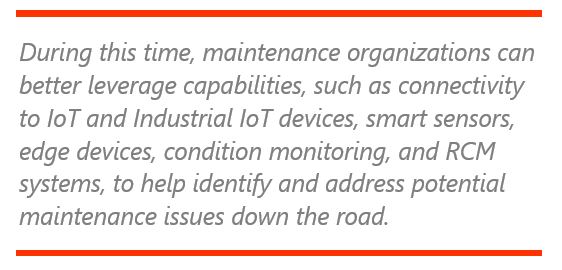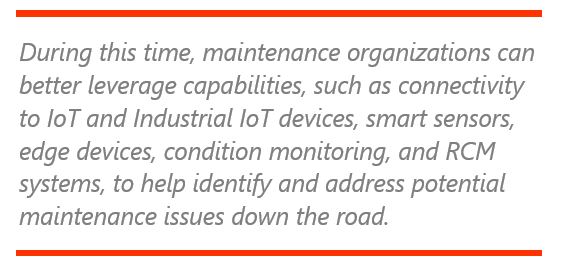Ed’s background includes roles in technology, consulting, manufacturing, robotics, supply chain management, and financial services. He has researched and written over 150 syndicated industry reports, executive briefs, viewpoints, and articles, and has been interviewed or quoted by such media and industry outlets as Fortune, Networld Media Group, Robotics Business Review, RoboBusiness, The Boston Globe, The Chicago Tribune, The Charlotte Observer, The LA Times, The New York Times, Truck Fleet MRO/Fleet Owner, and Yahoo Finance. Ed has also presented at a wide variety of customer and industry.
Rethinking Proactive Asset Management in the Age of Coronavirus
Blog: NASSCOM Official Blog
Proactive Asset Management is More Important Than Ever
The ramifications of the spread of the COVID-19 (virus Coronavirus) can be felt around the globe. The effects are far-reaching and can be felt in both human and economic terms. And with the latter, effective asset management is more important than ever, particularly as companies strive to ramp-up production in the near-to-intermediate term.
Even then, production will likely progress in fits-and-starts as the response to the virus continues. A highly functioning asset management plan can help to ensure that equipment is operating properly, and that downtime is kept to a minimum, both now and in the future.
Prioritizing Preventive Maintenance and Critical Inspections While Equipment is Available
With an increasing number of plants having to reduce output or temporarily suspend production, there will likely be time available to schedule much-needed inspections and maintenance. This would be particularly important in situations where scheduled  maintenance and inspections may have been cut short or deferred because plants have been operating at or near full capacity.
maintenance and inspections may have been cut short or deferred because plants have been operating at or near full capacity.
The time may be right to take full advantage of advanced features offered in intelligent Enterprise Asset Management (EAM) and Asset Performance Management (APM) systems, some of which may be underused. During this time, maintenance organizations can better leverage capabilities, such as connectivity to IoT and Industrial IoT devices, smart sensors, edge devices, condition monitoring, predictive maintenance, and Reliability Centered Maintenance (RCM) systems, to help identify and address potential maintenance issues down the road.
Other tools many maintenance teams can use are analytics, and particularly predictive analytics solutions, to better assess anomalies in the data and predict premature failures. The power of analytics is increasingly being used by business users and can yield significant benefits. Adoption of industrial analytics tools by shop floor personnel is increasing in lockstep with the many new and expanded capabilities that are now available to business users.
Many of today’s more savvy technicians understand basic analytics concepts and don’t require additional data science expertise. Methods, such as statistics, data mining, and data  visualization, are often used on a regular basis. For more information on the use industrial analytics, see the following ARC digital transformation viewpoint at https://www.arcweb.com/blog/extending-analytics-eam-other-users .
visualization, are often used on a regular basis. For more information on the use industrial analytics, see the following ARC digital transformation viewpoint at https://www.arcweb.com/blog/extending-analytics-eam-other-users .
Many maintenance organizations may now have an opportunity to work on tasks that have been on the back burner because of equipment being operated at, or near, full capacity. In addition to reviewing upcoming PM schedules, pending job plans, and potential anomalies identified by RCM systems, ramping up ad hoc inspections and considering pulling forward periodic maintenance can help ensure that equipment is ready for extended use, when needed.
Develop or Update Plans for Sourcing Spare parts and Replacement Equipment
In addition to scheduling labor tasks during shutdown time, it’s important that maintenance teams have a well-thought-out plan that includes redundant sources of spare parts and equipment. It’s critically important to know how prepared key suppliers for an unexpected event, and whether they would be able to maintain needed parts sourcing and deliveries. This is particularly important during such trying times.
Even though much emphasis has traditionally been placed on keeping a lean spare parts inventory, now may be the time to rethink this philosophy. Such uncertain times warrant discussions about whether, and by how much, to increase safety stock for critical parts to mitigate possible out-of-stock conditions and supply chain disruptions or vendor closures.
Summary and Conclusion
Amidst all this uncertainty and business disruption, the time may be right to be proactive when considering asset management strategies. This includes taking advantage of downtime, however unwelcome, to ensure that equipment is in the best condition possible when production and assembly lines are back at or near full capacity. This also a good time to review and update contingency plans for back-up sources for parts, equipment, and outsourced services.
“Reprinted with permission, original blog was posted here”. You may also visit here for more such insights on the digital transformation of industry.
About ARC Advisory Group (www.arcweb.com): Founded in 1986, ARC Advisory Group is a Boston based leading technology research and advisory firm for industry and infrastructure.
For further information or to provide feedback on this article, please contact RPaira@arcweb.com
About the Author:
The post Rethinking Proactive Asset Management in the Age of Coronavirus appeared first on NASSCOM Community |The Official Community of Indian IT Industry| :)).
Leave a Comment
You must be logged in to post a comment.








